Solar and Wind Off-Grid systems The batteries used to store solar and wind energy are currently mainly lead-acid batteries. The short lifespan and low cycle number of lead-acid batteries make it a weak candidate for environmental and cost-efficiency. Lithium-Ion batteries allow to equip solar or wind “off-grid” power stations, replacing the legacy banks of lead-acid batteries. Off-Grid energy storage has been complicated until now. We designed the Off-Grid Series with simplicity in mind. Every unit has a built-in inverter, charge controller, and battery management system. With everything packaged together, set up is as easy as connecting DC and/or AC power to your BSLBATT Off-Grid power system. A qualified electrician is recommended. 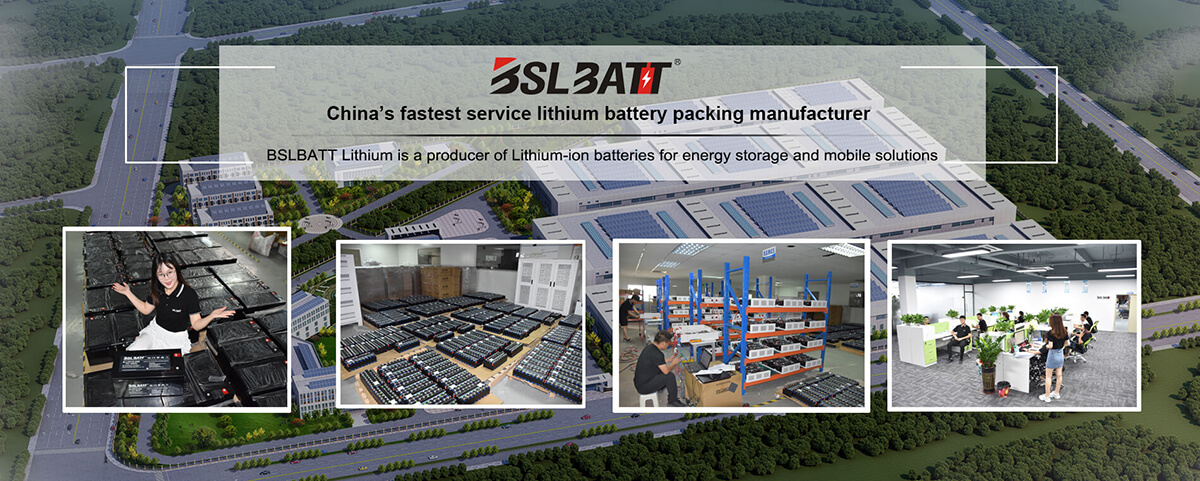 But why bother using Lithium-Ion Batteries if they are more expensive and more complicated? In the past five years, lithium-ion batteries were just beginning to be used for large-scale solar systems, but they have been used for portable and handheld solar systems for years. Due to their enhanced energy density and ease of transport, you should seriously consider using lithium-ion batteries when planning a portable solar energy system. While Li-ion batteries have their advantages for small, portable solar projects, I have some hesitation to recommend them for all larger systems. Most of the off-grid charge controllers and inverters on the market today are designed for lead-acid batteries, meaning the built-in set points for protection devices are not designed for lithium-ion batteries. Using these electronics with a lithium-ion battery would result in communication problems with the Battery Management System (BMS) protecting the battery. That being said, there are already some manufacturers that sell charge controllers for Li-ion batteries and that number is likely to grow in the future. Benefits : ● A lifetime (number of cycles) well above the lead-acid batteries (over 1500 cycles at 90% depth of discharge) ● Footprint and weights 2-3 times lower than lead-acid ● No maintenance required ● Compatibility with installed equipment (charge controllers, AC converters, etc.) by using advanced BMS ● Green solutions (non-toxic chemistries, recyclable batteries) We offer flexible and modular solutions to meet all types of applications (voltage, capacity, sizing). The implementation of these batteries is simple and fast, with a direct drop-in of legacy battery banks. APPLICATION: BSLBATT® system for Solar and Wind off-grid systems
But why bother using Lithium-Ion Batteries if they are more expensive and more complicated? In the past five years, lithium-ion batteries were just beginning to be used for large-scale solar systems, but they have been used for portable and handheld solar systems for years. Due to their enhanced energy density and ease of transport, you should seriously consider using lithium-ion batteries when planning a portable solar energy system. While Li-ion batteries have their advantages for small, portable solar projects, I have some hesitation to recommend them for all larger systems. Most of the off-grid charge controllers and inverters on the market today are designed for lead-acid batteries, meaning the built-in set points for protection devices are not designed for lithium-ion batteries. Using these electronics with a lithium-ion battery would result in communication problems with the Battery Management System (BMS) protecting the battery. That being said, there are already some manufacturers that sell charge controllers for Li-ion batteries and that number is likely to grow in the future. Benefits : ● A lifetime (number of cycles) well above the lead-acid batteries (over 1500 cycles at 90% depth of discharge) ● Footprint and weights 2-3 times lower than lead-acid ● No maintenance required ● Compatibility with installed equipment (charge controllers, AC converters, etc.) by using advanced BMS ● Green solutions (non-toxic chemistries, recyclable batteries) We offer flexible and modular solutions to meet all types of applications (voltage, capacity, sizing). The implementation of these batteries is simple and fast, with a direct drop-in of legacy battery banks. APPLICATION: BSLBATT® system for Solar and Wind off-grid systems
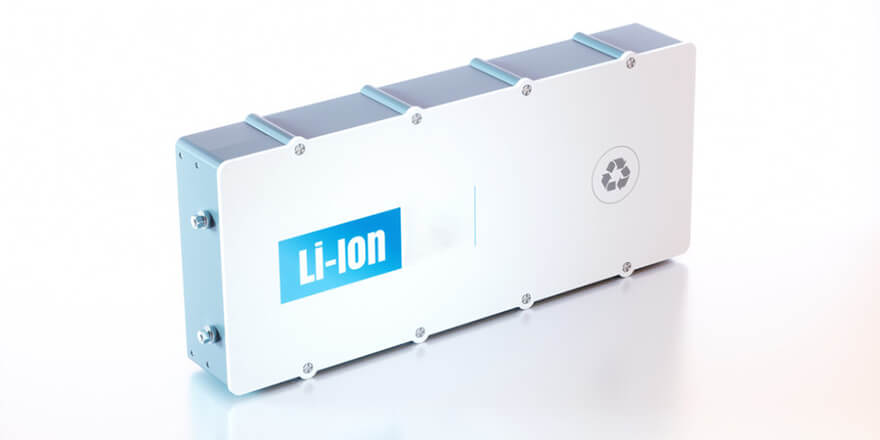 |
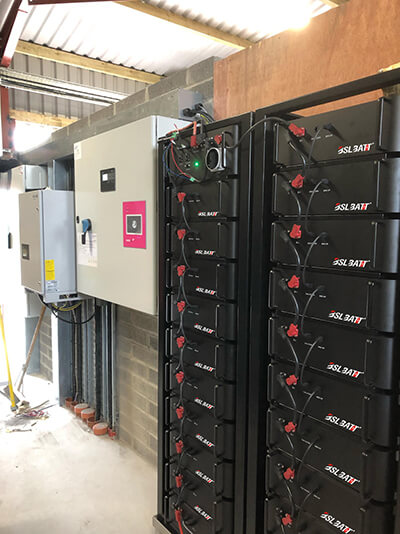 |
Could Lithium Batteries be cheaper than Lead-Acid? Lithium-Ion Batteries may have a higher upfront cost, but the long term cost of ownership can be less than other battery types. Initial Cost per Battery Capacity 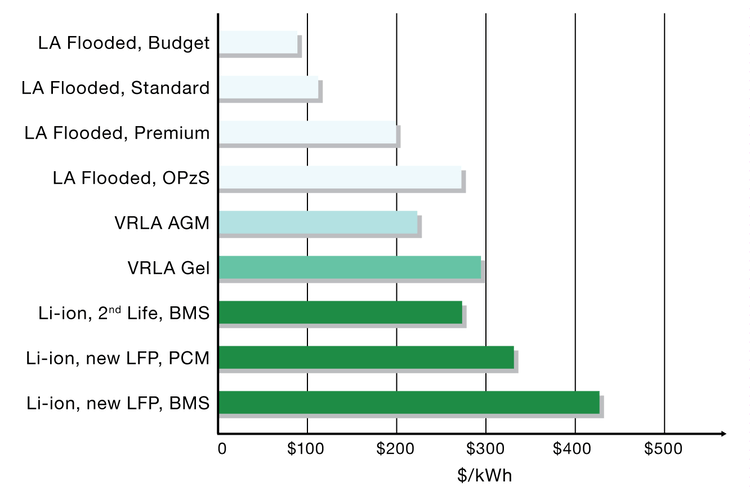 The Initial Cost per Battery Capacity graph incorporates: ●The initial cost of the battery ●The full capacity at 20-hour rating ●The Li-ion pack includes BMS or PCM and other equipment so it can be compared fairly to lead-acid batteries ●Li-ion 2nd Life assumes using old EV batteries Total Lifecycle Cost
The Initial Cost per Battery Capacity graph incorporates: ●The initial cost of the battery ●The full capacity at 20-hour rating ●The Li-ion pack includes BMS or PCM and other equipment so it can be compared fairly to lead-acid batteries ●Li-ion 2nd Life assumes using old EV batteries Total Lifecycle Cost 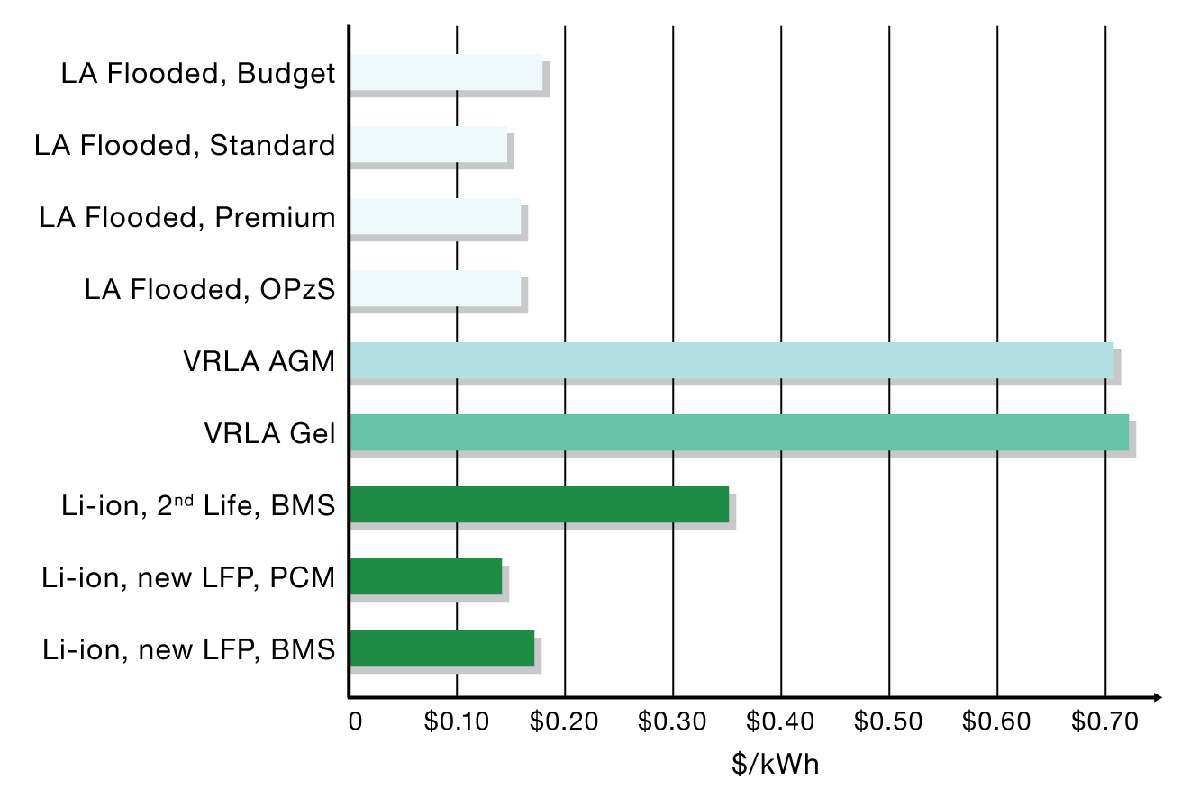 The Total Lifecycle Cost graph incorporates the details in the above graph but also includes: ● The representative depth of discharge (DOD) based on the given cycle count ●The round-trip efficiency during a cycle ●The number of cycles until it reaches the standard end of life limit of 80% State of Health (SOH) ●For the Li-ion, 2nd Life, 1,000 cycles were assumed until the battery was retired All the data used for the two graphs above utilized the actual details from the representative data sheets and market value. I choose to not list actual manufacturers and instead use an average product from each category. The initial cost of Lithium Batteries may be higher, but the lifecycle cost is lower. Depending on which graph you look at first, you can draw drastically different conclusions about which battery technology is most cost-effective. The initial cost of a battery is important when budgeting for the system, but it can be shortsighted to only focus on keeping the initial cost down when the more expensive battery can save money (or trouble) in the long run.
The Total Lifecycle Cost graph incorporates the details in the above graph but also includes: ● The representative depth of discharge (DOD) based on the given cycle count ●The round-trip efficiency during a cycle ●The number of cycles until it reaches the standard end of life limit of 80% State of Health (SOH) ●For the Li-ion, 2nd Life, 1,000 cycles were assumed until the battery was retired All the data used for the two graphs above utilized the actual details from the representative data sheets and market value. I choose to not list actual manufacturers and instead use an average product from each category. The initial cost of Lithium Batteries may be higher, but the lifecycle cost is lower. Depending on which graph you look at first, you can draw drastically different conclusions about which battery technology is most cost-effective. The initial cost of a battery is important when budgeting for the system, but it can be shortsighted to only focus on keeping the initial cost down when the more expensive battery can save money (or trouble) in the long run. 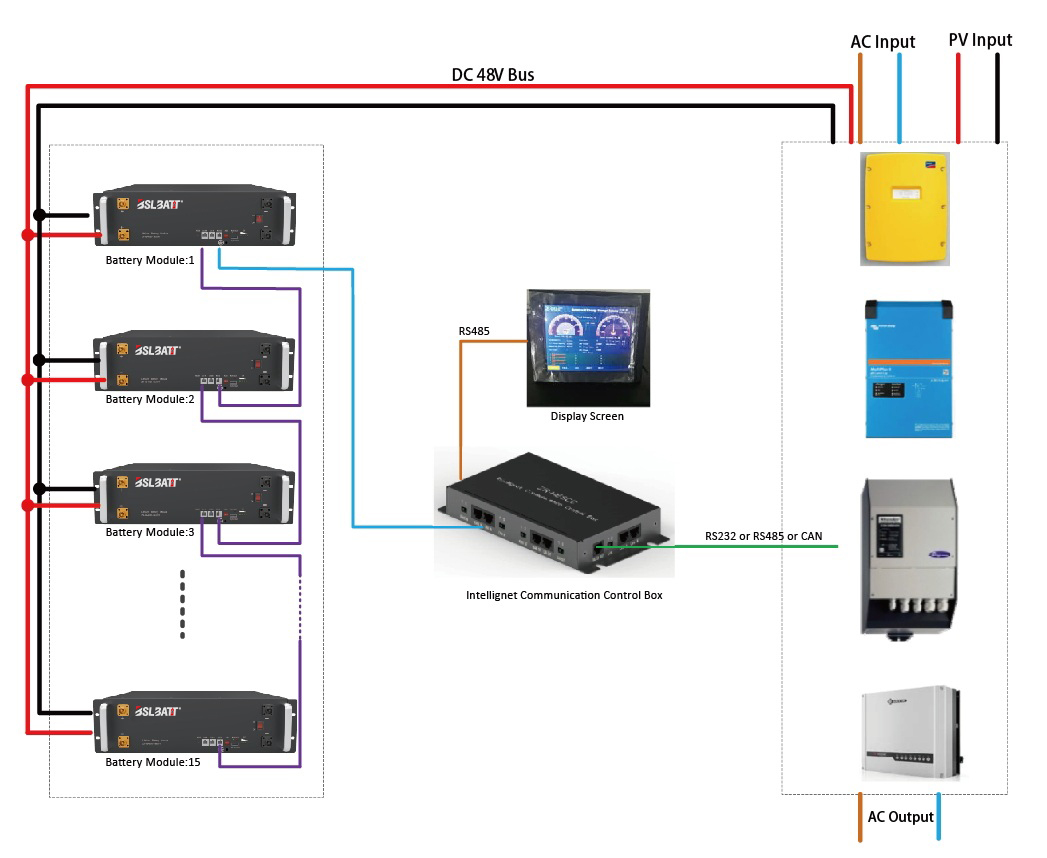 Lithium Iron vs. AGM Batteries for Solar The bottom line when considering between a lithium iron and an AGM battery for your solar storage is going to come down to purchase price. AGM and lead-acid batteries are a tried and true electricity storage method that comes at a fraction of the cost of lithium. However, this is because lithium-ion batteries typically last longer, have more usable amp hours (AGM batteries can only use about 50% of battery capacity), and are more efficient, safer, and lighter than AGM batteries. Thanks to the longer lifespan, frequently used lithium batteries will also result in a cheaper cost per cycle than most AGM batteries. Some of the tops of the line lithium batteries have warranties as long as 10 years or 6000 cycles. Solar Battery Sizes The size of your battery directly relates to the amount of solar energy you can store and use throughout the night or cloudy day. Below, you can see some of the most common solar battery sizes we install and what they can be used to power. ●5.12 kWh – Fridge + Lights for short term power outage (load shifting for small homes) ●10.24 kWh – Fridge + Lights + Other Appliances (load shifting for medium homes) ●18.5 kWh – Fridge + Lights + Other Appliances + Light HVAC use (load shifting for large homes) ●37 kWh – Large homes that want to operate as normal during grid outage (load shifting for xl homes) BSLBATT Lithium is a 100% modular, 19 inches Lithium-Ion battery system. BSLBATT® embedded system: this technology embeds BSLBATT intelligence providing incredible modularity and scalability to the system: BSLBATT can manage ESS as small as 2.5kWh-48V, but can easily scale up to some large ESS of more than 1MWh-1000V.
Lithium Iron vs. AGM Batteries for Solar The bottom line when considering between a lithium iron and an AGM battery for your solar storage is going to come down to purchase price. AGM and lead-acid batteries are a tried and true electricity storage method that comes at a fraction of the cost of lithium. However, this is because lithium-ion batteries typically last longer, have more usable amp hours (AGM batteries can only use about 50% of battery capacity), and are more efficient, safer, and lighter than AGM batteries. Thanks to the longer lifespan, frequently used lithium batteries will also result in a cheaper cost per cycle than most AGM batteries. Some of the tops of the line lithium batteries have warranties as long as 10 years or 6000 cycles. Solar Battery Sizes The size of your battery directly relates to the amount of solar energy you can store and use throughout the night or cloudy day. Below, you can see some of the most common solar battery sizes we install and what they can be used to power. ●5.12 kWh – Fridge + Lights for short term power outage (load shifting for small homes) ●10.24 kWh – Fridge + Lights + Other Appliances (load shifting for medium homes) ●18.5 kWh – Fridge + Lights + Other Appliances + Light HVAC use (load shifting for large homes) ●37 kWh – Large homes that want to operate as normal during grid outage (load shifting for xl homes) BSLBATT Lithium is a 100% modular, 19 inches Lithium-Ion battery system. BSLBATT® embedded system: this technology embeds BSLBATT intelligence providing incredible modularity and scalability to the system: BSLBATT can manage ESS as small as 2.5kWh-48V, but can easily scale up to some large ESS of more than 1MWh-1000V.  BSLBATT Lithium offers a range of 12V, 24V, and 48V Lithium-Ion battery pack to meet most of our customer needs. The BSLBATT® battery offers a high level of safety and performance thanks to the use of new generation lithium iron phosphate Square aluminum shell cells, managed by an integrated BMS system. BSLBATT® can be assembled in series (4S maximum) and parallel (up to 16P) to increase operating voltages and energy stored. As battery systems continue to advance, we will be seeing more people using these technologies and we expect to see the market improve and mature, much as we have seen with photovoltaic solar over the last 10 years.
BSLBATT Lithium offers a range of 12V, 24V, and 48V Lithium-Ion battery pack to meet most of our customer needs. The BSLBATT® battery offers a high level of safety and performance thanks to the use of new generation lithium iron phosphate Square aluminum shell cells, managed by an integrated BMS system. BSLBATT® can be assembled in series (4S maximum) and parallel (up to 16P) to increase operating voltages and energy stored. As battery systems continue to advance, we will be seeing more people using these technologies and we expect to see the market improve and mature, much as we have seen with photovoltaic solar over the last 10 years.
Post time: May-08-2024








